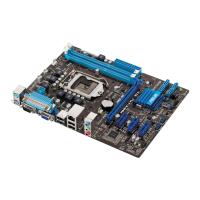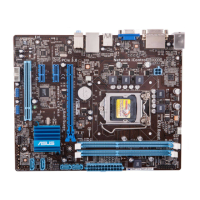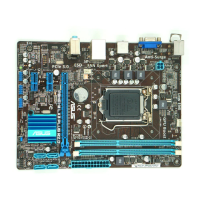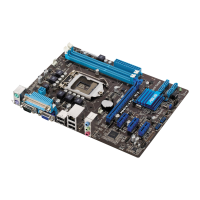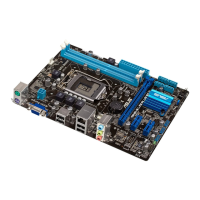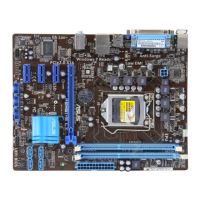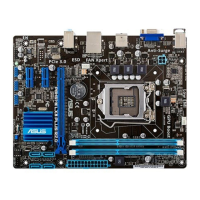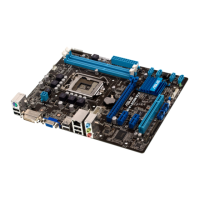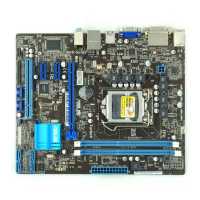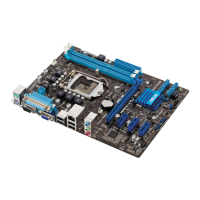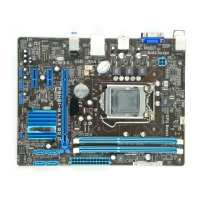
Do you have a question about the Asus P8H61-M LX3 and is the answer not in the manual?
| Form Factor | Micro ATX |
|---|---|
| Chipset | Intel H61 |
| CPU Socket | LGA 1155 |
| Memory Slots | 2 |
| Memory Type | DDR3 |
| Max Memory | 16 GB |
| PCIe x16 Slots | 1 |
| SATA Ports | 4 x SATA 3Gb/s |
| Audio Chipset | Realtek ALC887 |
| Ethernet | 10/100/1000 Mbps |
| USB Ports | 8 x USB 2.0 |
| Audio | Realtek ALC887 |
| LAN | Realtek 8111E |
| Video Outputs | D-Sub |
Safety guidelines for handling and operating the motherboard and its components.
Explains the manual's organization, content, and purpose for users.
Explanation of symbols, warnings, and typography used in the manual for clarity.
Lists resources for further product and software updates from ASUS.
Details on supported processors, Intel H61 chipset, and DDR3 memory support.
Information on expansion slots, Gigabit LAN, audio, and USB ports.
Specifications for integrated graphics and SATA storage connectors.
Highlights proprietary ASUS features, capacitors, and internal connectors.
Lists package contents, support DVD, and motherboard dimensions.
Greeting and list of items included in the motherboard package.
Details the main benefits and capabilities of the motherboard's core components.
Highlights proprietary ASUS technologies and software utilities.
Critical safety steps to prevent damage during component handling and installation.
Instructions for correct motherboard orientation and securing it in the chassis.
Visual guide to motherboard components, connectors, and their numbering.
Step-by-step instructions for safely installing the CPU into the socket.
Guide for properly attaching the CPU heatsink and fan assembly.
Instructions for safely removing the CPU heatsink and fan assembly.
Details on supported memory sizes, speeds, and qualified vendors.
Step-by-step guides for inserting and removing memory modules from the DIMM slots.
Procedures for fitting and setting up expansion cards in available slots.
Details on PCI Express x1 and x16 slots and their supported devices.
Instructions for clearing CMOS settings via the CLRTC jumper.
Details the various ports on the motherboard's rear I/O panel.
Describes internal headers for chassis components like audio and power buttons.
Guidance on installing compatible operating systems and service packs.
Details the contents of the support DVD and how to use its utilities.
Covers BIOS update utilities (ASUS Update, EZ Flash, BIOS Updater) and backup.
Methods for entering and navigating the BIOS setup utility.
Description of the user-friendly EZ Mode for basic system configuration.
Details the Advanced Mode for in-depth BIOS configuration and explains menu bar items.
Explains how to interact with BIOS menus, windows, and keys.
Settings for BIOS display language, system date, and system time.
Options for setting administrator and user passwords for system security.
Adjusts memory operating frequency and timings for performance.
Manages CPU power states, speed, and thermal behavior.
Settings related to CPU features, cores, and performance.
Settings for graphics, memory controllers, PCH, and SATA devices.
Manages USB ports and enables/disables integrated motherboard devices.
Power management settings, including wake-on-LAN and AC power loss behavior.
Shows real-time CPU, motherboard temperatures, and fan speeds.
Controls CPU and chassis fan speeds based on temperature for cooling and noise management.
Displays voltage outputs and enables/disables surge protection.
Specifies the sequence of devices the system attempts to boot from.
Configures NumLock state, logo display, and error response during boot.
Utilizes tools for BIOS updates, memory info, and saving/loading BIOS profiles.
Options for saving changes, loading defaults, discarding changes, and exiting the BIOS setup.
Statements regarding compliance with various international radio and digital apparatus regulations.
Details on chemical substance compliance and environmentally responsible disposal.
Formal declarations of compliance with FCC and European Union directives.


